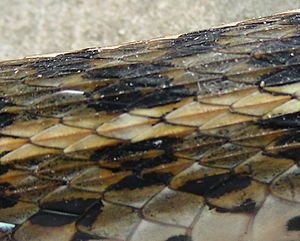Keeled scales facts for kids

Keeled scales are a special type of scale found on some reptiles, like snakes and lizards. Instead of being smooth and shiny, these scales have a raised ridge down their middle, almost like a tiny keel on a boat. This ridge makes the scales feel rough if you touch them.
Contents
What Are Keeled Scales?
Keeled scales are a unique feature on the skin of many reptiles, especially snakes and some lizards. Imagine a tiny bump or ridge running right down the center of each scale. This ridge makes the scale feel rough, not smooth. It's like a small mountain range on the reptile's body!
How Keeled Scales Look and Feel
Unlike flat, smooth scales, keeled scales have a raised line or "keel" in the middle. This keel can be short or run all the way to the tip of the scale. If you were to gently run your finger along a snake with keeled scales, you would feel the texture. Reptiles with smooth scales, on the other hand, feel sleek and slippery.
Where Are Keeled Scales Found?
You can find keeled scales on many different types of reptiles. They are very common on snakes, especially vipers and some types of colubrids. Lizards like some skinks and iguanas can also have them. The location of these scales can vary; sometimes they cover the whole body, and sometimes only certain parts.
Why Do Reptiles Have Keeled Scales?
Keeled scales aren't just for show; they serve several important purposes that help reptiles survive in their environments. These special scales give reptiles advantages in movement, camouflage, and even protecting themselves.
Better Grip and Movement
One big advantage of keeled scales is improved grip. For snakes that live in sandy or loose soil areas, the rough texture helps them push off the ground more effectively. It's like having tiny cleats on their bellies! This extra grip also helps them climb trees or move across rough surfaces without slipping.
Excellent Camouflage
The rough surface of keeled scales can help a reptile blend into its surroundings. The ridges break up the light reflecting off the snake's body, making it look less shiny and more like the rough bark of a tree or the texture of rocks. This makes it harder for predators or prey to spot them. It's a natural form of camouflage!
Protection from Predators
The rough texture of keeled scales can also offer a bit of protection. If a predator tries to grab a snake with keeled scales, the rough surface might make it harder to hold on. It can also make the snake feel less appealing to eat, giving the snake a chance to escape.
Animals with Keeled Scales
Many fascinating reptiles have keeled scales. Here are a few examples you might know:
- Rattlesnakes: Most rattlesnakes, like the Western diamondback rattlesnake and the Timber rattlesnake, have keeled scales. This helps them move across rocky or sandy desert terrain.
- Vipers: Many vipers, including the Puff adder and the Common European adder, are known for their keeled scales. This often gives them a dull, non-reflective appearance, which helps them hide.
- Water Snakes: Some water snakes have keeled scales, which can help them grip slippery surfaces near water or even provide some traction in the water itself.
Not all snakes have keeled scales. Many snakes, like corn snakes or king snakes, have smooth scales. The type of scales a snake has often depends on where it lives and how it moves.
Gallery
-
Puff adder (Bitis arietans)
-
Common European adder (Vipera berus)
-
Horned rattlesnake (Crotalus cerastes)
-
Western diamondback rattlesnake (Crotalus atrox)
-
Ottoman viper shows typical non-reflective appearance of reptiles with keeled scales
-
Timber rattlesnake (Crotalus horridus)
-
Puff Adder (Bitis arietans)











